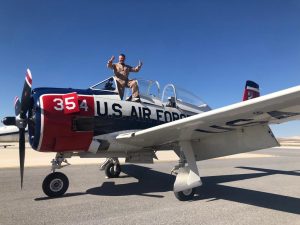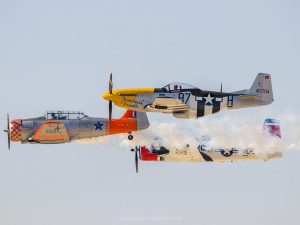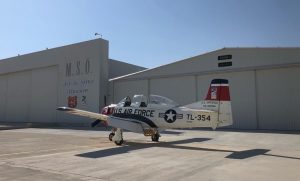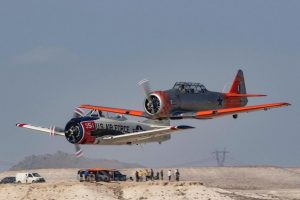TURKISH ADVENTURE PART 5 OF 8
 I have to say a big thanks to all the staff at the M.S.Ö. Air and Space Museum at the Sivrihisar Aviation Centre in Turkey, especially Ali İsmet Öztürk, a renowned Turkish professional display pilot, recently retired. Without the support and trust of Ali, his family and the staff, I would not be able to have the content to write these short aviation stories! I would also like to Thank Gabriel for taking the time to check me out and let me loose in the T-28 Trojan.
I have to say a big thanks to all the staff at the M.S.Ö. Air and Space Museum at the Sivrihisar Aviation Centre in Turkey, especially Ali İsmet Öztürk, a renowned Turkish professional display pilot, recently retired. Without the support and trust of Ali, his family and the staff, I would not be able to have the content to write these short aviation stories! I would also like to Thank Gabriel for taking the time to check me out and let me loose in the T-28 Trojan.
During the run-up to the Sivrihisar air show, I was fortunate enough to be checked out on some of the museum’s prized possessions, the Boeing Stearman and the T-28 Trojan. This is a dream for any pilot, and I was happy to take on the challenge! Below, I will just mention some of the main points I remember from flying the T-28. Please forgive me for missing a lot of detail, as this is just a quick synopsis of the experience and linked in only allows short stories.
 My first impression of the T-28 when I got close to the beast was the size of it! It was huge compared to the T6 Texan and the Hurricane I have been most familiar with over the last two years. The aircraft I was about to fly was built in 1955. A potent aircraft and a delight to fly with its 1,425 horsepower Wright R-1820-86 engine.
My first impression of the T-28 when I got close to the beast was the size of it! It was huge compared to the T6 Texan and the Hurricane I have been most familiar with over the last two years. The aircraft I was about to fly was built in 1955. A potent aircraft and a delight to fly with its 1,425 horsepower Wright R-1820-86 engine.
From a historical point of view, it doesn’t have the glamour of the WW2 fighters as she was designed purely as a complex trainer designed in such a way that it would train jet pilot candidates for the F-86 and the F9F, I believe. However, this trainer did see combat in a variety of conflicts, such as Vietnam and Algeria.
You don’t get into a T-28. You mount it! It’s a massive aircraft, and you must scale the outside like a climbing wall to get in. It has enough baggage space for everything, including the kitchen sink! With the flap down, you have various footholds to help you climb onto this monster plane. Once inside, you feel like you are in a jet fighter, it has that feel about it, and that’s exactly how it was designed and does exactly what it says on the tin! More systems than I was used to, but after soaking up the POH and some excellent ground school, I was ready.
 Starting the aircraft from the checklist was straightforward, and the taxi was very simple compared to most of the tail wagers I have recently flown. The take-off was predictable and exhilarating; I eased the throttle forward to 30 inches of manifold pressure holding the brakes, then released the brakes. As soon as the T-28 started to move, I pushed the throttle to the stop giving around 48 inches. The Trojan accelerated light a jet! The right rudder was needed; however, with a 5* right rudder bias, it almost flew itself off the runway. The engine is canted down and to the right and intentionally done by the designers to help offset the engine’s torque and reduces the amount of rudder needed on take-off.
Starting the aircraft from the checklist was straightforward, and the taxi was very simple compared to most of the tail wagers I have recently flown. The take-off was predictable and exhilarating; I eased the throttle forward to 30 inches of manifold pressure holding the brakes, then released the brakes. As soon as the T-28 started to move, I pushed the throttle to the stop giving around 48 inches. The Trojan accelerated light a jet! The right rudder was needed; however, with a 5* right rudder bias, it almost flew itself off the runway. The engine is canted down and to the right and intentionally done by the designers to help offset the engine’s torque and reduces the amount of rudder needed on take-off.
As soon as the gear was up, I powered back to thirty-six inches and 2,400 rpm; the aeroplane settled down to a 120-knot climb, and she was rock solid.
Climb rate of two and three thousand feet per minute from memory. If you wanted to fly above 16 thousand feet (which I didn’t), you could engage the second stage of the supercharger. The aircraft typically cruises at a true airspeed of around 200 knots (232 mph) at 10,000 to 25,000’ MSL, and in the cruise configuration of 26–28” MAP and 1,850–2,000 rpm, they burn about 45 gph.
 What I liked most about the Trojan was its predictability, throttle response and excellent controls; it seemed that at any speed, when trimmed correctly, it could be controlled easily with a very light touch and the roll rate was certainly faster than the P-51 Mustang. The Trojan is powerful, sophisticated and has beautifully balanced controls. A large, exceptionally well laid out cockpit, outstanding visibility, and excellent handling. Aerobatics, I would say that the T-28B could hold its own with most WW2 Warbirds, an incredibly capable machine and here I was flying one! Who would have thought this?
What I liked most about the Trojan was its predictability, throttle response and excellent controls; it seemed that at any speed, when trimmed correctly, it could be controlled easily with a very light touch and the roll rate was certainly faster than the P-51 Mustang. The Trojan is powerful, sophisticated and has beautifully balanced controls. A large, exceptionally well laid out cockpit, outstanding visibility, and excellent handling. Aerobatics, I would say that the T-28B could hold its own with most WW2 Warbirds, an incredibly capable machine and here I was flying one! Who would have thought this?
Landing the Trojan was effortless as she settled nicely onto the tarmac, which was a lovely surprise. I was a little focused on the landing due to sitting so high above the ground; however, it was quite intuitive, and I managed to land this big bird consistently.
I could write a lot more about this aircraft however, Linked in only allows short stories so that I will add to this on my blog at some point. I hope you enjoyed this brief insight into this very understated, high-performance aircraft.
To be continued ……….